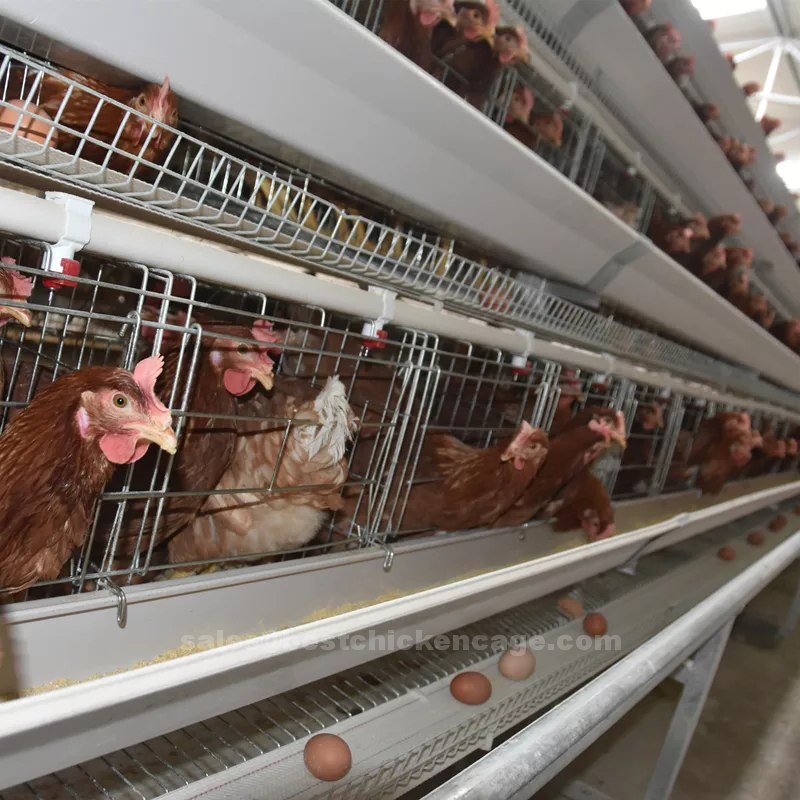Cage structure of layer cage Importance of resulting in higher yields and greater revenue for farmers
Cage structure of layer cage
Layer cages are the most commonly used equipment for raising chickens. Their structure is also of concern to farmers. So, layer cage manufacturers have summarized the structure of common laying hens for reference by farmers. The size of the laying hens’ cage is generally 42 cm in front height, 35 cm in height, 37 cm in cage depth, and the cage width which is cage length depends on the feeding and drinking position. Generally, the cage width is 42-45 cm, the slope of the cage bottom is about 1.0 degree, and the egg collecting trough outside the cage is 12-16 cm, the layer chicken cage consists of the front, back, top, bottom and side nets. Place the trough and sink in the front net. In order to facilitate the feeding and drinking of chickens, a vertical wire fence with a diameter of 3 mm can be welded, the distance between the grids is about 5-6 cm, and the lower edge is 4-5 cm away from the bottom net to leave a gap for the production of eggs. The next egg rolls out in time. In order to facilitate the catching of chickens, it is generally necessary to open the cage door on the front net, and the lead wire of the cage door is thicker
The rear net and the side net are mainly used for chicken battery cage spacing, and are generally used together with adjacent cages. In order not to let the chicken head stick out to fight with the chicken in the adjacent cage, the mesh wire should be arranged horizontally, with a spacing of 3 cm, and a few vertical wires for reinforcement and support. The top net is mainly to prevent the chickens from escaping, the wire spacing can be appropriately relaxed, and the cage door can be set on the top net
In the layer cage, the bottom net is where the chicken stands, both to bear the weight of the chicken, to make the chicken stand stable, and to facilitate the collection of eggs and defecation. Therefore, the requirements for the cage bottom are higher. The longitudinal lead wire at the bottom of the cage should have certain elasticity. It should not be too thick
 Features
Features
1. The multi-tiered structure of the layer chicken cage maximizes space utilization, allowing farmers to rear a larger number of hens within a limited area
2. The cage design includes designated nesting areas that provide comfortable and secure spaces for hens to lay eggs, making egg collection more efficient and stress-free for both farmers and hens
3. The layer chicken cage prioritizes the welfare of the hens, providing them with adequate space, ventilation, and easy access to food and water, which is essential for their well-being and productivity
4. The organized layout of the cages streamlines daily farming operations, making it easier for farmers to monitor and care for the hens
5. The design of the cage system facilitates easy waste removal, promoting better hygiene and reducing the risk of disease outbreaks
Let us send you the required information by post. Just click on this link to let us know which products you are interested in
1. Automatic poultry cage system
2. Poultry farm equipment
Bookmark our website and leave message on our website now to getting guiding to choosing right poultry equipment and enquiry for your poultry farm, we are the designer, manufacturer and supplier of poultry farm turnkey projects
Importance of cages
1. The controlled environment of the cage system promotes consistent and increased egg production, resulting in higher yields and greater revenue for farmers
2. The multi-tiered structure allows farmers to maximize space, making the layer chicken cage ideal for poultry farms with limited land resources
3. The cage system provides hens with designated spaces for nesting, feeding, and roosting, ensuring their well-being and reducing stress levels, ultimately leading to healthier and more productive chickens
4. Layer chicken cages are a cost-effective solution for egg production, as they allow farmers to rear a larger number of hens in a smaller space, optimizing resources and labor
5. The nesting areas in the layer chicken cage provide a comfortable and secure space for hens to lay eggs, resulting in cleaner and higher-quality eggs, which are more appealing to consumers
Our services
1. We offer expert guidance on starting and managing your poultry farm
2. Tailored housing and infrastructure design for optimal bird health
3. Our team makes customized feeding plans to maximize production efficiency
4. We offer veterinary services and disease prevention strategies
5. Insights into market trends and strategies for product placement
6. We provide educational workshops on poultry farming practices
Frequently ask questions
Q: Are battery cages cruel to the birds?
A: Battery cages are often criticized for restricting the natural behaviors of hens, leading to concerns about animal welfare and cruelty. Critics argue that the limited space and lack of amenities in these cages cause stress and discomfort to the birds
Q: Are battery cage eggs safe to eat?
A: Battery cage eggs can be safe to eat if proper hygiene and food safety practices are followed during production and handling. However, some consumers choose to avoid them due to ethical or animal welfare reasons
Q: Are battery cages being phased out?
A: In many countries, there is a growing trend toward phasing out battery cages in favor of alternative housing systems that provide more space and better living conditions for hens
